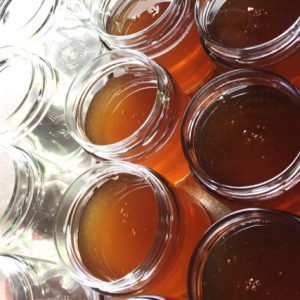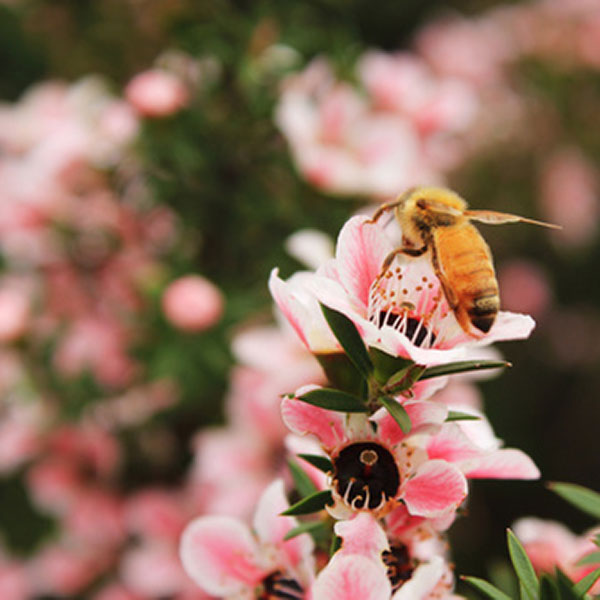Interesting facts about honey
Honey is a natural product, available in hundreds of varieties, colours, consistencies and flavours. So far so good, but where does it come from, what is in it and is it really healthy? Why are some honeys liquid and others not, and what is so special about Manuka Honey? We’ve answered the most important questions for you.
What is honey?
Honey is a natural, sweet substance produced by bees (Apis mellifera) by transforming nectar from flowers and other plant secretions (honeydew) by combining them with their own specific substances, storing them, dehydrating them and allowing them to be stored and matured in the combs of the beehive (ref. European Directive 2001/110/EC).
The bees use the honey as food for their brood and themselves. Honey is harvested in the apiary with enough honey remaining in the hive for the bees to feed on. In the winter, when the bees are no longer able to collect food, they are fed by the beekeeper or feed on their own honey supplies.
What is honey made of?
Honey is a natural, sweet substance produced by bees (Apis mellifera) by transforming nectar from flowers and other plant secretions (honeydew) by combining them with their own specific substances, storing them, dehydrating them and allowing them to be stored and matured in the combs of the beehive (ref. European Directive 2001/110/EC).
The bees use the honey as food for their brood and themselves. Honey is harvested in the apiary with enough honey remaining in the hive for the bees to feed on. In the winter, when the bees are no longer able to collect food, they are fed by the beekeeper or feed on their own honey supplies.
Why are there different types of honey?
Honey essentially consists of various types of sugar (including fructose, glucose, sucrose), water, enzymes, vitamins, minerals and pollen. In the case of blossom honeys, the sugar content is around 70-80%. Honeydew honeys such as forest honey have a lower sugar content of approx. 50-60%. Depending on the flower type, either the fructose or the glucose content in honey predominates.
How to obtain honey of a certain variety?
Honey naturally comes from different plants and from different regions around the world. Depending on which flowers, trees or bushes the bees collect nectar or honeydew, the honey obtained from them has different properties. The honeys differ in their color, consistency, sweetness and aroma.
A basic distinction is made between multifloral and monofloral honeys. Multifloral honeys are obtained from the nectar of many different flowers.
A monofloral honey (type-specific honey) must predominantly come from a single source and is created when the bees mainly fly to a single plant species. Well-known examples of type-specific honeys are acacia honey, rapeseed honey, forest honey or manuka honey.
What is raw honey?
Of course you can’t tell the bees where to fly. So, in order to extract honey from a particular flower, a beekeeper positions his hives close to as many of the desired flowers as possible, e.g. at the edge of a rapeseed field for rapeseed honey, or in a forest for forest honey. Most bees will fly to the desired flowers. Despite a small amount of honey from other flowers in a monofloral honey, the majority of the pollen in the honey will come from the same botanical origin and the taste, smell and appearance are typical of the variety. The honey is called monofloral honey.
My honey is crystalline - is that bad?
When honey is described as ‚raw‘, it usually has not been processed more than absolutely necessary on its way into the jar.
During the honey crop, the honeycombs in which the bees store the honey are removed from the beehive and extracted in a honey extractor. Besides the honey, wax residues, plant particles and other impurities are extracted from the combs. The honey must therefore be sieved before it is filled into the jar. In order for the honey to be liquid and flowable for filtering and filling, it is usually gently warmed and liquefied.
The honey is therefore not completely untouched, but ideally, it is processed very gently to preserve its valuable ingredients. Gently-processed honey is still considered a raw food!
How long does honey last?
Honey naturally consists largely of sugars, namely glucose, fructose and sucrose. The sugar content and the fructose-glucose ratio vary, depending on the botanical origin of the honey.
Since these sugars are both liquid and can take on crystalline forms, honey crystallizes sooner or later. If the glucose content predominates, honey tends to crystallize more quickly.
But that’s not a bad thing and a completely natural process.
Whether and how long a honey is liquid depends on the individual sugar composition and does not define the quality or purity of the honey.
If you want to liquefy a crystallized honey again, you can warm it up slowly and gently. In a warm water bath the sugar crystals melt and the honey becomes liquid again. But be careful: too much heat damages the enzymes in the honey! So don’t expose the honey to more than 50 ° C.
What do the different shades of honey tell me?
Depending on the flowers from which the honey comes which define the honey type, the color and consistency can vary greatly. Lighter honey types such as Acacia honey often have a milder and sweeter taste. Darker varieties such as buckwheat honey or forest honey usually taste stronger and more spicy.

The color of the honey is determined by the source of nectar or honeydew. It is influenced, among other things, by plant dyes such as carotenoids or flavonoids from pollen and the mineral content. The higher the mineral content, the darker the honey.
What is Manuka Honey?
Manuka honey is the honey from the nectar and pollen of the New Zealand South Sea myrtle (Leptospermum scoparium), also called Manuka or tea tree.

Manuka-blossom
Manuka only grows in the mountainous regions of New Zealand and southeast Australia, which makes this honey a rarity.
The honey of the Manuka plant contains the ingredient methylglyoxal (MGO) naturally in up to 100 times higher concentrations than other types of honey. Methylglyoxal is a substance which, according to a study by the Technical University Dresden in 2006, has been shown to have an antibacterial effect.
However, the food law and the EU guidelines do not allow any health claims for Manuka honey. Officially, no health-related effects can be attributed to Manuka honey. It is up to everyone to explore and research the special properties of Manuka honey and gain experience on its effects.
What is MGO all about?
Methylglyoxal (MGO) or ist precursor dihydroxyacetone (DHA) only gets into the Manuka honey via the nectar of the Manuka trees. Methylglyoxal is a product which, according to a study by the Technical University Dresden (2006), was able to demonstrate an antibacterial effect. The ingredient is contained in other honeys in small concentrations as well, but so far, it has only been possible to detect it in manuka honey in concentrations of approx. 100-800 mg/kg. This is up to 100 times higher than in other types of honey. The special feature of Manuka honey compared to other honeys is the significantly higher MGO content.
An MGO value of 250+ means that at least 250 mg MGO per kg can be detected. The higher the MGO content, the more valuable the honey
Why is honey analysed?
Honey is a natural raw material whose natural properties such as taste, color and consistency are influenced by many factors. These factors are the botanical and geographic origin of the honey, the harvest time, and natural or artificial environmental factors. Nevertheless – or precisely because of this – there are certain quality requirements defined in the German Honey Ordinance that must be met to sell honey as‘ table honey‘.
These quality features can be measured and this is exactly what happens with a honey analysis. Our honey is analyzed to ensure that it meets all legal requirements and our individual quality requirements.
What can be checked during a honey analysis?
Just about everything! There is a sophisticated, scientific method of analysis for almost every parameter.
Not every analysis is necessary or useful for all honeys.
Analyzes that are carried out for most honeys include e.g:
- Determination of the honey type and origin (pollen analysis)
- Measurement of sugar composition, water content and diastase (enzyme activity)
- Classification of smell, taste, color, consistency
- Residue and adulteration analyses
All of these and many other analyses can provide information on the type, origin, quality and purity of a honey.
Why is honey not suitable for toddlers (under 12 months of age)?
Honey may contain spores of the bacterium Clostridium botulinum. They can occur as natural contaminants in honey. Pollen, the digestive tract of the honeybee, dust, air, earth and nectar or, if necessary, feed materials for bees are considered as a source of contamination.
Honey is a more or less “raw” natural product that is processed as little as possible to preserve the natural and valuable ingredients of honey. However, this can also go hand in hand with the fact that these spores can still be present in food honey. This is not a problem for people with healthy intestinal flora. In infants, on the other hand, the intestinal flora has not yet developed to the point that germs such as clostridia can be kept at bay. In this case, the spores can germinate and possibly lead to a life-threatening illness.
For children over one year of age and for adults, honey is usually not dangerous to consume. If you are unsure whether you can enjoy honey (or other raw foods) without worries, we recommend to consult a doctor. A final assessment can only be made by a medical professional.